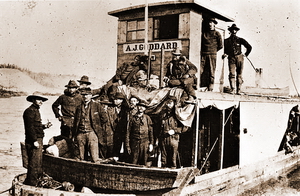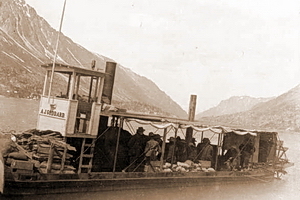|
Gramophone Identified on Klondike-Era Shipwreck
by Jim Eadie

|
|
Klondike Gold Rush era sternwheeler A.J. Goddard
(courtesy Yukon Archives)
|
|
|
The well-known poem by Robert Service,
titled The Cremation of Sam McGee,
describes vividly the real sufferings of
gold miners attracted to the Klondike gold rush
beginning in the late 1890s, and muses about the
strange things happening in the midnight sun on
the marge of Lake Labarge during a Klondike
gold rush era winter storm. Is it possible that the
cremation was accompanied by recorded music
from a passing steamboat?
In 1897, a small sternwheeler, the "A.J. Goddard",
was placed into service during the gold rush
on the lakes and Yukon River system leading
to Dawson City. The small iron steamboat was
manufactured in San Francisco, and sailed to
Alaska. There, the boat was dismantled and
hauled over mountain passes to Lake Labarge
where it was reassembled. Val Monahan,
Conservator of Yukon Museum Collections says,
"The A.J. Goddard was very small and much less
fancy than most boats. A real rough and ready
little vessel, the deck had only a canvas cover. It
was used to move people at first, but its main role
was to haul firewood, freight and supplies and to
tow scows."
During an October 1901 storm on Lake Labarge,
the boat sank. Two passengers clung to wooden
debris and were rescued the following morning.
The three crewmembers drowned and their bodies
were recovered the following spring along a
shoreline.
The exact location of the sunken boat was
unknown until 2008, when a sonar survey of Lake
Labarge conducted by the Yukon Transportation
Museum located an unknown vessel. Subsequent
follow-up in 2010 confirmed that it was the
A.J. Goddard, extremely well preserved and
remarkably undisturbed at the bottom of the lake
in 40 feet of very cold water.
In June 2010, an international archaeology
team supported by the Institute of Nautical
Archaeology, Ocean Gate, the Government of
Yukon, the Yukon Transportation Museum and
others worked to document the vessel and its
contents.

|
|
Klondike Gold Rush era sternwheeler A.J. Goddard
(courtesy Alaska State Library)
|
|
|
A crew member’s jacket and boots still lay on the
deck, there were scattered dishes and tools, and
even the fire-box of the boiler was still open. It
was clear that the ship’s fireman had been trying
to throw in firewood to get more steam in a hurry.
An axe was also resting on the deck where it had
been abandoned by a crewmember.
But .. most interesting, and not identified at the
time of recovery from the wreck in 2010, was a
small wooden box and several associated parts
and discs. Proper forensic procedures were
followed. Artifacts recovered in water must
remain in water until the time for examination.
This means transporting and storing those items
in suitably sized containers filled with water.
Exposure to air can cause considerable damage in
a hurry.
These items were forwarded to Tara Grant, a
conservationist at the Canadian Conservation
Institute in Ottawa, Ontario, to be examined. It
was immediately evident that the found items
were an old external-horn wind-up gramophone
of some sort and three disc records. As the horn
was not among the recovered items, a further dive
was conducted to search for the horn and any
other possible parts and pieces, without success.
been abandoned by a crewmember.
"It is likely still on the floor of Lake Labarge",
said Val Monahan.
Lindsay Thomas, lead archaeologist at the time
of the finds, said, "Finding the gramophone was
a really big shock. Most of the other items were
what you would expect to find at a shipwreck. It
demonstrated that music was really important to
the people of the gold rush."
The gramophone likely belonged to one of
the crew members of the ship! It would have
been dismantled, packed with the records and
carried along with other belongings over the icy
mountain passes, and by steamship or dog-sled to
the Klondike, in much the same way that the AJ
Goddard had arrived!

|
|
The gramophone and records as recovered from the A.J. Goddard wreck,
prior to conservation treatment
(Yukon Government press release #11-032, Feb 28, 2011)
|
|
|
Although no nameplate or tags were found on the
gramophone, examining the case, components,
and placement of spring mechanism and crank
identified it as an 1897-1899 Berliner Style 5 –Trademark or
Trademark-Late Model hand-crank gramophone.
Further examination was conducted on the
records, one of which was broken. Disc records
at that time did not have paper labels, but the
information was stamped into the hard rubber
discs. The three recovered discs were gently
brushed to reveal the stamping. The records have
been identified as:
- The Harp that Once thro’ Tara’s Halls by
Thomas Moore - Berliner 1645Z, recorded
9 November 1897 in New York, singer J. W.
Myers.
- Ma Onliest One by Fay Templeton - Berliner
991Z, recorded 17 April 1896, singer Len
Spencer.
- Rendez Vous Waltz - Berliner 1464Z, recorded
1 July 1897, performed by the Metropolitan
Orchestra. This recording is available on
the Library of Congress on-line collection
"Emile Berliner and the Birth of the Recording
Industry" at Rendez Vous Waltz
Ma Onliest One was the last song to be played
by the crew, as it was still on the gramophone
turntable. The discs will likely never be able
to be played, as the grooves are filled with
iron oxide that is almost impossible to remove
without damaging the artifacts.
Interestingly, during her research, Lindsay
Thomas found an advertisement in the
Canadian Music Trades Journal in 1901
showing a similar, if not identical, gramophone
and three records selling as a package for
$15. (Canadian Music Trades Journal 1901:3;
Library and Archives Canada).
It is clear that music was an incredibly important
part of surviving in and documenting of the
Klondike gold rush. Most popular music at that
time included minstrel songs, old Irish tunes and
waltzes, all of which are represented in the A.J.
Goddard recovery. For the most part they were
simple songs which could be easily performed by
amateur musicians who may have brought along
their own instruments.

|
|
Berliner Gram-o-phone advertisement
(Library and Archives Canada/Canadian Music Trades Journal/
AMICUS 113380/Vol.2, #6, May 1901, Page 3)
|
|
|
Lindsay Thomas, also a Masters student at
Texas A&M University (Nautical Archaeology
Program), summed up: "The gramophone was the
most surprising find of the season, and by far the
most interesting. Found on one of the smallest
and most utilitarian Yukon River steamboats, this
small luxury provides an insight that is incredibly
valuable to understanding life on board."
This past year, the A.J. Goddard shipwreck was
designated an historic site. The gramophone and
discs will be returned to the Yukon Archaeology
Program once full examinations have been
completed. A future exhibit of the A.J. Goddard
recovery is presently being designed by the
Yukon Transportation Museum, at which time the
gramophone and discs will be on display for the
public to view.
"There are strange things done in the midnight
sun, by the men who moil for gold; The Arctic
trails have their secret tales …….."
Yes …. it is possible that, as Sam McGee roasted
on the marge of Lake Labarge ….the faint strains
of recorded music from a Berliner Gramophone
may have been heard blowing with the wind that
night.
Notes
- Video clips of the shipwreck accompanied
by the original disc recording of Rendez Vous
Waltz can be viewed at Yukon News
- Yukon Transportation Museum would be
extremely interested in obtaining digitized
copies of the original recordings of the other
two discs recovered, if it is possible that any
CAPS members may have the original discs.
Resources Used
- Interview May 2011 – Valery Monahan,
Conservator, Museum Collections,
Government of Yukon.
- Interview May 2011 – Lindsey H. Thomas,
Nautical Archaeology Program at Texas A&M
University, and lead archaeologist for A.J.
Goddard recovery.
- Press Release #11-032 Yukon Government
February 28, 2011. "Gold Rush Era music
from the A.J. Goddard wreck identified".
- Release of Institute of Nautical Archaeology,
November 23, 2009. "Perfectly Preserved
Gold Rush Ghost Ship Discovered in Canada’s
Sub-Arctic".
- Whitehorse Star article by Justine Davidson,
November 24, 2009. "Historic Shipwreck
found in Lake Labarge".
- MURRAY, Jean A. 1999 "Music of the Alaska-
Klondike Gold Rush: Songs and History".
University of Alaska Press, Anchorage.
- THOMAS, Lindsey H. untitled and not
yet completed Master’s thesis, Nautical
Archaeology Program, Texas A& M University.
- Yukon Transportation Museum, 30 Electra Cr.,
Whitehorse, Yukon, Y1A 6E6. Telephone
867-668-4792 (Yukon Transportation Museum)
- Yukon Archives, 400 College Dr.,
Whitehorse, Yukon. Telephone 867-667-5321
(Yukon Archives)
|